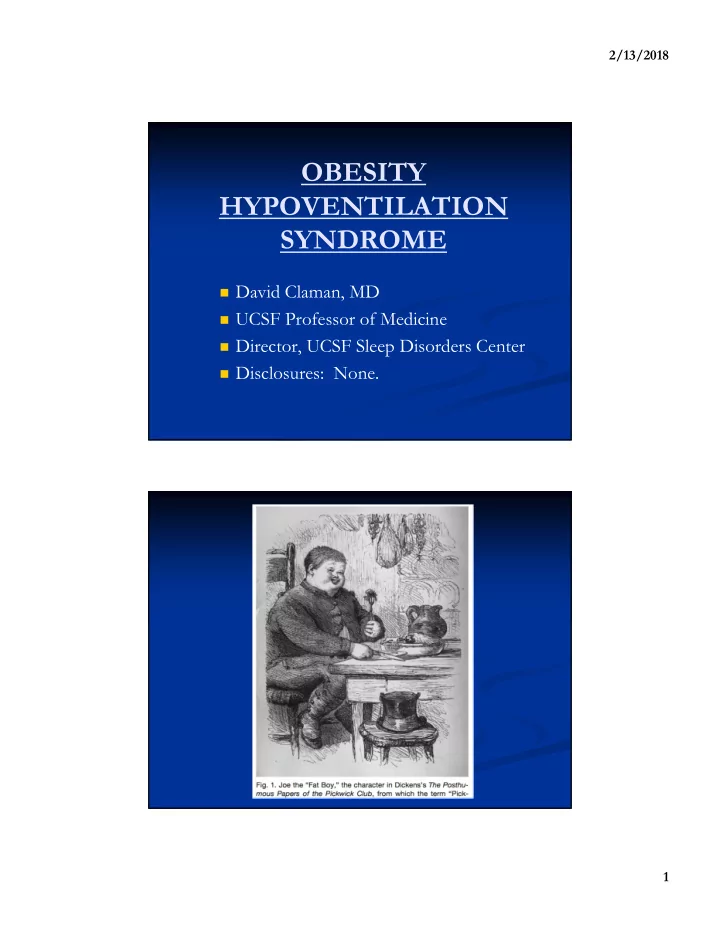

2/13/2018 OBESITY HYPOVENTILATION SYNDROME David Claman, MD UCSF Professor of Medicine Director, UCSF Sleep Disorders Center Disclosures: None. 1
2/13/2018 COMPLICATIONS OF OSA Cardiovascular HTN, CHF, CVA, arrhythmia, Pulm HTN Excessive daytime sleepiness Polycythemia Obesity hypoventilation syndrome (OHS) “ Overlap ” syndrome – COPD & OSA together Obesity Hypoventilation (OHS) Mokhlesi B. OHS State of Art Review. Respir Care 2010;155(10):1347-1362 Combination of obesity (BMI > 30) and daytime hypercapnia (PaCO2 > 45) Symptoms: EDS, fatigue & morning headaches similar to OSA 90% will have sleep-disordered breathing (AHI>5) Need to exclude other causes of hypercapnia (PFTs) Hypoxemia in office or during PSG ABG most accurate assessment for pCO2 Prolonged hypoxemia during PSG Macavei et al; Predictors of OHS; J Clin Sleep Med 2013;9:879-884 Serum bicarbonate >27 is 85% sensitive; 89% specific Bicarb >27: 68% positive prective value and 95% neg pred value TRT90 (sleeping sat<90% = 30% v control 11%) 2
2/13/2018 Mokhlesi B. Sleep Breath 2007;11:117-124 HYPERCAPNIA IN OSA French Multicenter Study; n=1141 from database Excluded those with FEV1<80% Overall prevalence of 11% with PaCO 2 >45 BMI < 30 – prevalence 7.2% BMI 30-40 – prevalence 9.8% BMI > 40 – prevalence 23.6% Laaban J-P. Chest 2005;127:710-715 Similar results in Italy and US: Mokhlesi B. Chest 2007;132:1322-1336 3
2/13/2018 INCREASED MORTALITY IN OHS If untreated, approx 23% mortality at 1-1.5 yrs Treated with NPPV: mortality 3% at 1.5 yrs Mokhlesi B et al. Proc Am Thorac Soc 2008(5):218-225 PICKWICK STUDY: NIV v CPAP Masa JF et al. AARCCM 2015;1:86-95 221 subjects with AHI>30; pCO2 50, bicarb 30, BMI 44 NIV (AVAPS: IPAP 18-22/EPAP 4-8; Rate 12-15; tidal volume 5-6 cc/kg) v CPAP v Lifestyle; oxygen in 20-25% of each group for 88-92% sat Treatment for 2 months; compliance 5.3 hours/night NIV & CPAP improved symptoms and sleep study results NIV showed improved pCO2 v control, and better pulmonary fxn than CPAP; both NIV and CPAP improved serum bicarb Improvement correlated with compliance Conclusion : NIV (AVAPS) & CPAP statistically superior to usual care; NIV yielded better respiratory results 4
2/13/2018 RANDOMIZED TRIAL: BiLevel vs CPAP Piper AJ. Thorax 2008;63(5): 395-401 45 subjects; 9 excluded due to persistent hypoxemia on initial CPAP titration BMI 52-54; pCO2 49-52; bicarb 30 N=36 randomized to CPAP (13-14) vs Spontaneous BiLevel (avg 16/12) 3-4 subjects in each group on oxygen After 3 months, same adherence, improved symptoms (less sleep; higher O2 and lower CO2 Conclusion: in subjects without hypoxemia on CPAP, Spontaneous BiLevel and CPAP were equally effective AVAPS v BiLevel ST: Randomized Trial Murphy PB. Thorax 2012;67:727-734 50 patients (23 in each group completed study); single blind; BMI 50; pCO2 52; Bicarb 31 AVAPS 657 ml tidal volume (2 on oxygen) BiLevel ST 25/10 (4 on oxygen) Back-up rate 14 in both groups Compliance 5.3 hours; similar changes in both groups pCO2 reduced to 47; bicarb reduce to 28 Conclusion: no significant difference in treatment outcomes between AVAPS and BiLevel ST 5
2/13/2018 CPAP & BILEVEL FOR OHS Spanish retrospective analysis of 54 patients (18 women) with OHS; mean BMI 44 Perez de Llano LA et al. Chest 2005;128:587-594 Overall, all patients had improved PaCO 2 and PaO 2 on treatment; 5 weaned from treatment after weight loss Modality When discharged Outpt f/u CPAP 3 16 Bilevel 49 30 Volume ventilator 2 3 Oxygen 47 31 TREATMENT SUMMARY Weight loss! CPAP or Spontaneous BiLevel can be effective for OHS patients with only mildly elevated PaCO2 Bilevel ST or AVAPS for Severe patients! Oxygen often necessary in severe cases Physiology can be dynamic: Patients may need NIV + oxygen initially, and then need re-study to adjust therapy and also to see if oxygen can be discontinued Ventilation control improves over 4-6 nights of treatment (Berthon-Jones M et al. Am Rev Respir Dis 1987;135:144- 7) 6
2/13/2018 CONCLUSIONS OHS complicates 10-15% of OSA patients OHS has higher mortality risk if untreated Basic treatment should always include weight loss For Severe cases: BiLevel ST or AVAPS treatment with oxygen if needed Consider CPAP or spontaneous BiLevel for milder cases 7
Recommend
More recommend